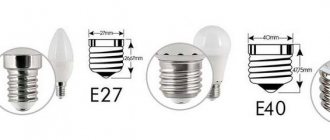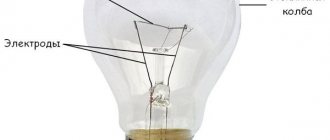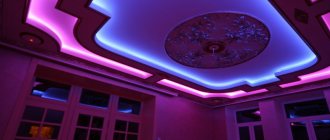Concept of color temperature
According to the definition given by Max Planck, color is the temperature of a completely black body at which it produces radiation of the same tone as the radiation in question. When heated, metals give off a characteristic glow. As the value increases, the spectrum shifts towards yellow, then white, blue and violet. Each color has its own temperature. To put it simply, color temperature shows the shade of light emitted by the source.
Used in astrophysics, colorimetry, photography, optics and other scientific research.
Important! The emission spectrum of LEDs is slightly different. It is not the same as that of metals, since crystals are obtained in a different way. But the essence is the same - the selected shade is obtained at a certain color temperature. It is important to note that it is not related to the heat generated by the lighting fixture.
Units
The parameter is measured in degrees Kelvin (K). It is a unit of thermodynamic temperature according to the International System of Units. 0 K equals 273 degrees Celsius. Kelvin was originally used as a unit of measurement relative to the triple point temperature of water. Now this value is also used in lighting. In determining color temperature, Kelvin characterizes the course of the radiation intensity of a light source.
What we measure
Measuring color temperature gives an idea of the spectral composition of the source and its color. Data on the actual heating of the source is measured by other indicators. It is impossible to obtain an exact value by eye; expensive professional equipment is used to carry out measurements.
How does it work in everyday life?
A similar temperature principle is used when creating lighting fixtures and choosing them for rooms. Each LED light bulb has its own color temperature, which the buyer needs to consider when purchasing. The quality of lighting directly affects the health of residents, resistance to stress, and fatigue.
What it is?
Color temperature (CT) is the hue of a light source. According to Planck's formula, it is defined as the temperature of a completely black body emitting light comparable to the color of the radiation source.
Color temperature is a characteristic of visible light and has important applications in lighting, photography, film, publishing, manufacturing, astrophysics, horticulture, and other fields. In practice, it only makes sense for light sources that most closely match blackbody radiation, that is, on the line from reddish-orange and yellow to white and blue-white.
The temperature of light is not the actual temperature of the body - a hot surface produces heat, but it is not blackbody radiation. That is, the term “temperature” has nothing to do with how hot the light bulb feels to the touch.
Incandescent lamp
The color temperature of incandescent lamps is approximately 2,700 K, while the filament heats up to the same temperature, which classifies this type of lighting as electromagnetic thermal radiation of light.
Many other light sources, such as fluorescent lamps or LEDs, emit light primarily through processes other than thermal radiation. That is, the emitted radiation does not follow the shape of the black body spectrum. Such light sources are classified as correlated color temperatures - the temperature of an absolutely black body, which is in a hot state and has certain properties.
Fluorescent lamps
The color temperature of fluorescent lamps is characterized by comparison with a completely black body. Changing the indicators changes the properties of the components of the color spectrum. When crossing a certain point on the Kelvin scale, an increase in blue light and a decrease in red are observed; when the temperature decreases, the opposite changes occur.
LED lamp
The color temperature of LEDs when illuminated does not use thermal heating sources - with radiation of 2,700 K, they heat up to a maximum of 80º C.
Color temperature scale
The characteristic is measured in the range from 800 K to 20,000 K. The lower limit (800 K) corresponds to the beginning of the visible dark red glow of a hot body. Further, the tones approach yellow, and reach sunlight at noon (5000 K). The color spectrum then becomes bluer until it reaches the blue sky of the polar latitudes (20,000 K).
Color temperature table
| Colorful temperature | Light source |
| 1000 K | Candles |
| 2500-2800 K | Incandescent lamp |
| 3000-3200 K | Sunset, halogen light bulb |
| 3500 K | Morning and evening sun |
| 3800-4500 K | Fluorescent lamps |
| 4500 K | Afternoon sun |
| 5500 K | Flash |
| 6000 K | Overcast |
| 6500 K | Deep shadow at noon |
| 7000 K | Shade in light cloudy weather |
| 7500 K | Shadow on a cloudless day |
| 10000 – 15000 K | Cloudless sky, northern day. |
Color rendering index and color temperature
The color rendering index (or CRI – color rendering index) indicates the ability of the eye to perceive color gradation. So, for example, in candlelight, green and brown will look similar. That is, if the color temperature is below 3200 K, then color perception deteriorates.
Similar: Laying cables in pipes as an installation method
The color rendering index CRI is measured in numbers, the maximum value of which is 100. A light source with a coefficient of 100 optimally displays all colors and shades, for example, for sunlight this indicator is one hundred units. The lower this parameter, the worse the tones are transmitted.
Thus, we can distinguish 4 main categories of color rendering:
- 100 – corresponds to the perception of the color of an object when illuminated by sunlight or an incandescent lamp.
- 90–100 – fairly high color rendering.
- 80–90 – color rendition is still high, but not so accurate.
- less than 80 – CRI quality is low.
Based on these indicators, you can select a suitable light source for a particular purpose. So, for a workspace, it is better to give preference to LEDs with an indicator in the range of 90 – 100, and for corridors, utility rooms and other domestic premises - 80 and lower (since high quality of color reproduction is not so important here).
Please note that the quality of color rendering does not depend in any way on color temperature. A good example is a mercury lamp, its colorimetric temperature is 5900 K (high) and its color quality is 22 (poor).
Glow color marking
LED lamps are divided into 3 groups:
- WW (warm write) – warm shades with a spectrum of 2700-3300 K;
- NW (neutral white) – neutral colors 3300-5000K;
- CW (cool white) – cool white color with emission of more than 5000 K.
CRI is labeled as:
- 1A – means the best color rendering 90Ra;
- 1B – very good color rendering 80-89Ra;
- 2A – good 70-79 Ra;
- 2B – average 60-69 Ra;
- 3 – sufficient – 40-59 Ra;
- 4 – bad, below 39 Ra.
Interesting! The marking is indicated on the packaging. The need to introduce the parameter is due to the fact that two sources with the same temperature can produce different colors.
Relationship between color temperature and lighting
Accurate knowledge of the color temperature of the LED lamp from the table helps determine what color the device will have. All sources are divided into several groups - warm, neutral and cold shades. The first category includes LED lamps operating in the range of 2700K – 3200K. Used in apartments and houses. Neutral – 3500-5000K. Such lamps are installed in offices, classrooms, and are suitable for the bathroom or hallway at home. Cold - above 5000 K, they resemble bright daylight. Such devices are installed in medical institutions, laboratories, and parks.
Color temperature of LED lamps
Without delving into the classification of LEDs in detail, we can say that the basis for their differences lies in such a characteristic as the color temperature of LED lamps. This concept dates back to the school physics course, and therefore applies not only to LEDs.
Simply put, each shade of white light has a different “temperature” at which we can distinguish colors. It is measured in Kelvin. On packaging with light LED lamps in warm white and cool shades, the temperature of the emitted light is usually indicated. From them you can understand approximately in what color range the lamp will shine.
The color temperature of LED lamps is the visual effect created by the human eye in relation to the radiation source. That is, each lamp has its own color spectrum in relation to sunlight.
Important! Typically, sunlight has a neutral white tint, which we see in offices and sometimes in hospitals.
The closer the spectrum is to bright yellow sunlight, the warmer the lighting in the room becomes, and vice versa. If the spectrum moves away from sunlight towards a blue tint, the cooler the light the lamp emits. This effect applies not only to LED lamps, but to all others. There is a scientific explanation for this. When a piece of metal is heated at high temperatures, it can produce radiation that appears in a certain shade. At first there will be a red color, increasing the temperature further, it will constantly fade: yellow, white, blue, indigo, etc. Although diodes have a slightly different operating principle, the essence remains the same as that of conventional incandescent lamps. So, for example, LED lamps with a color temperature in Kelvin that is below 5500K have a warmer light, and the lamp receives cold light only at values above this. LED lamp color temperature table:
Warm LED lamps have the following indicators on the packaging:
- 2000K - orange radiation in this indicator can be compared to the light of a burning candle or the inside of a fire flame. Lower indicators, which are characteristic of red radiation, are not used in the manufacture of LED lamps for the home. The red color contrasts strongly against the background of all the natural shades that a person observes in nature and the environment;
- 2500K - yellow radiation is produced by increasing the “temperature” of the color. This shade can also be observed at sunrise. This is the most suitable shade for lighting living rooms in an apartment. LED lamps scatter warm white light better than bright orange, so light yellow light gives a feeling of comfort and tranquility.
The warm LED light doesn't stop there. Depending on the temperature readings on the packaging, you can make one or another shade of light more pronounced or, conversely, bring it closer to neutral. LED lamps are white or, as it is also called, “neutral” with an indicator of 5500K/5227°C - as close as possible to natural sunlight outside in the middle of the day. It is the most familiar to the human eye and does not cause a feeling of irritation. Popular E27 LED lamps give a warm shade, like other lamp models. Therefore, to achieve the effect of natural light, several lamps with such lamps are enough.
- 9000K is a cool blue tint. This indicator is rarely used in residential premises. Because in practice, digital values take on the color of a thermonuclear reaction, which is almost impossible to see in real life. However, shade values close to neutral are actively used by marketers and advertisers.
What is color
As already mentioned, the color temperature can be used to determine the color of the source. In the tables, the lower limit of color temperature corresponds to a bright red glow (from 1000 K). Rising higher, the indicator becomes yellower and reaches a neutral white color. Then blue appears in the shade.
How many kelvins are there in warm light?
Very warm colors include a range of color temperatures from 2500 K to 2800 K. Warm shades lie between 2800 K and 3500 K.
Cool white light: how many kelvins
Cool colors include all those with a color temperature above 5000 K. Daylight - 6000 K. Blue shades appear from 6000 K to 8000 K, and blue colors appear from 8000 K.
2700 Kelvin - what light
A 2700K lamp produces a yellowish white color. Such sources are used in a classic interior in a home environment. Not only LED lamps, but also classic 100 W incandescent light bulbs have 2700 K.
What color does a 3000 Kelvin lamp produce?
3000 K is given by a 200 W incandescent lamp and a halogen light source. Refers to warm shades. LED lamps with such a glow can be used to illuminate kindergartens, halls and living rooms, kitchens, and hallways.
Color temperature 4000 k
The neutral shade of 4000K is close to natural white. Closer to morning sun or afternoon sunshine.
4300 Kelvin: color
Fluorescent lamps have a temperature of 4300 Kelvin. This value is also close to natural sunlight in the morning and lunch hours. In automotive technology, standard xenon headlights also have a color temperature of 4300 K.
Choosing LED lamps for the home
An interesting fact is that under different lighting the same room can look different. You just have to change the color of the lighting, and it will immediately envelop you in coziness and comfort, or, on the contrary, mobilize and fill you with energy.
Warm white light 2700–3200 K
LEDs with this range are installed in bedrooms, living rooms, and children's rooms, giving them comfort and allowing those present to relax. Also, if you use such light in the dining area, the prepared food will look more appetizing. The spectrum of warm white light in this range is similar to the light of a conventional incandescent lamp.
Neutral white light 3200–450 K
Suitable for bathroom, toilet, office, classroom. The radiation is visually similar to the morning light of the sun, which means it awakens and increases performance, adds energy and mood. It can be installed in the kitchen in the cooking area, creating a feeling of cleanliness and freshness.
Cool white light over 4500K
It is used for high-tech style rooms, but it suppresses the nervous system, so it is not advisable to use it in large quantities.
A living space can combine several functions, that is, you can both relax and work in the living room. Therefore, the option of combined lighting is suitable. When the main light is selected with warm shades of LED lamps, and the desktop is equipped with neutral white sources. Also, mirrors can be illuminated with white light, then applying makeup and performing other procedures will be more comfortable.
For a child’s desk, it is better to choose a lamp with a color temperature of 3200–3500 K; such proximity to the white spectrum will allow you to get ready and get into a working mood. Also pay attention to whether the light bulb is covered with a shade to protect your eyes from direct radiation.
The work of manufacturers is aimed at developing settings for controlling the glow of LEDs and adjusting color temperature. This will allow you to use the necessary lighting in the room depending on the situation. So far, smart lamps are not so widespread because they are expensive.
Related: What are smart bulbs?
Which light is better, warm or cold?
LED lamps used in lighting are divided into cold and warm. The psychological and emotional state of the residents of the house depends on the type of color. LED lamps with a warm glow are suitable for evening time. They help you fall asleep faster, relax, and create comfort. Cool tones are most natural for daytime. It invigorates and keeps a person in good shape.
The use of cold and warm colors at inappropriate times can disrupt the functioning of the body. It is important to remember that light is also affected by lampshades, shades and other diffusers.
Important! With age, the lens of the human eye begins to age and becomes yellowish, as a result of which visible objects acquire yellowish tints. Cool tones help in this situation.
Also, at different ages, people perceive lighting differently. As age increases, distortion occurs, which also needs to be taken into account. Mental characteristics also influence color perception.
Answering the question of what is better - a cold or warm color, the answer will be a combination of shades. It would be desirable to also be able to control the lighting fixtures individually.
Warm light in Kelvin
Warm color starts at 800 K and ends at 3500 K.
Color temperature and our emotions
The light provided by an LED lamp can influence a person’s condition. For this reason, it is important to make the right choice of lamps for your home and office. Warm colors are calming, while cold colors are invigorating. Thus, warm light of 2700 K creates a warm and cozy atmosphere. 4100K – bright, clean, productive atmosphere. 5000K and above – alarm, brightness.
Important! The bluish springs have an energizing effect on the psyche and stimulate the body. If used excessively, such tones can cause the opposite effect - lethargy, depression.
Which lamps to choose for the office
Office and work spaces are best illuminated with neutral LED lamps. Some businesses and offices can even be lit with LED lamps with a cool glow of 4100 K. It is not recommended to use lamps below 4100 K on a regular basis.
Which lamps are suitable for home
Yellowish shades are suitable for the home - for example, 3000 K LED lamps. They are best used in the morning for a gentle awakening and in the evening for a calming effect. Such ice lamps can be installed in the bedroom and living room.
For offices, kitchens, bathrooms and other rooms where people stay for a short time, it is better to install LED lamps with a neutral glow. Lamps with a color temperature above 5300K are not used in residential premises; they are suitable for warehouses and industries.
SP 52.13330.2011
The color of any physical body is determined by its spectral composition and the nature of the lighting that affects it. This means that when the same object is illuminated with LED lamps with different color temperatures, this object will have different shades. In order to set certain standards, SP 52.13330.2011 “Natural and artificial lighting” was developed.
SP 52.13330.2011 is an updated version of SNiP 23-05-95, valid in Russia until May 20, 2011.
SP 52.13330.2011 establishes standards for all types of lighting used in buildings and structures, in production and in open areas. Regarding the color of light, the document provides for the use of artificial sources, the color temperature of which should not go beyond 2400-6800°K.
In addition to a number of norms and rules, SP 52.13330.2011 provides recommendations for lighting of various types of premises. For example, in residential areas it is recommended to use yellowish-warm light temperatures that create a cozy atmosphere, and in work areas it is recommended to use cooler light temperatures that promote a working atmosphere.
Main conclusions
The color temperature parameter is the most important for LEDs and lamps based on them. The color of the source glow depends on it. Color temperature is measured in the range from 800 K (dark red glow) to 20000 K (bright blue sky at polar latitude), LED lamps are usually manufactured with a value of 2000-6500 K. Shades of glow can be divided into warm (yellow), neutral and cool ( blue) tones. Yellowish ones are used in residential areas (bedroom, nursery, living room). Neutral - in the kitchen, bathroom or office. Cold tones are not used at home. The psychological and emotional state of a person directly depends on this value. Yellow tones are calm and cozy. Blues, on the contrary, charge with energy.
Previous
LEDsFeatures and characteristics of the emergency power supply for LED lamps
Next
LEDsDevice features and circuit diagram of 220 V LED lamps











